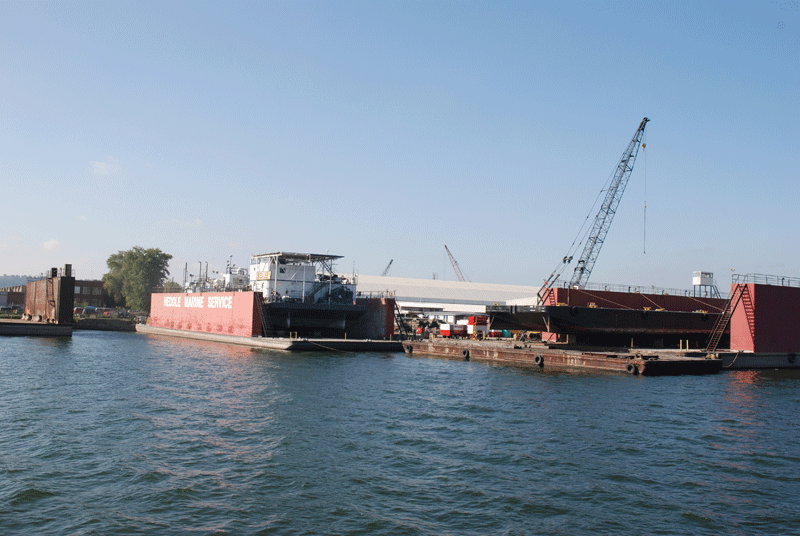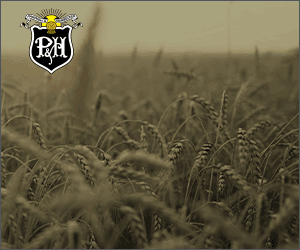The St. Lawrence Seaway
INVESTMENTS AND CHANGING REGULATIONS
SINCE 1679, COMMERCIAL ships have plied the waters of the St. Lawrence moving goods from the Great Lakes to the Atlantic. Today, 165 million metric tonnes (MT) of cargo is shipped through these waterways within North America every year.

“The farming community is extremely important to our business and to the Great Lakes St. Lawrence shipping industry as a whole,” says Captain Scott Bravener, president and CEO of Lower Lakes Towing Ltd.
His company operates 15 vessels (with a 16th under construction), including four traditional bulk carriers which are primarily used for agricultural commodities. These vessels move more than 24 million net tonnes annually within the Seaway system, including 2.5 million tonnes of agricultural commodities.
This year, for the second year in a row, ice cover on the lakes made the first few weeks of the shipping season difficult. However, Bravener says, “the marine shipping industry has the capacity and resiliency to serve our customers well, no matter what the circumstances.”
He notes that despite the slow start to ice melt in 2014, ships delivered over 12 million metric tonnes of grain via the St. Lawrence Seaway — the most in 14 years.
A COMPETITIVE ADVANTAGE
The major Great Lakes ports serving farmers are Hamilton, Windsor, Sarnia, Goderich, Owen Sound, Johnstown, Port Colborne, and Oshawa. These ports not only take away grain at harvest time, but are also important ports for receiving crop inputs, such as fertilizer.
Port destinations for Ontario grain include Toledo, Buffalo, Montreal, Soral, Trois Rivières, Quebec, Baie Comeau, and Port Cartier. Bulk carriers move the grain to the lower St. Lawrence River where it is then transferred onto ocean going vessels for transport overseas.
Grain tonnage shipped through the system is on the rise due to increased capacity, better crop yields, and more demand from export markets.
“The food safety chain of Ontario crops makes them highly attractive to customers in Europe, the Middle East, and Asia,” says Bravener. “Future growth opportunities will be driven by continuing to grow the Ontario brand as a quality supplier with a secure, safe, and trustworthy pipeline.”
Bravener also notes that keeping products on the water as long as possible translates into savings for processors. “Due to their large carrying capacity and new technology, Great Lakes ships are fuel efficient. One Great Lakes vessel can carry enough grain in one trip to make enough bread for everyone in Ontario for a month. This economy of scale saves companies $3.6 billion per year in annual transport savings compared to all-land alternatives.”
IMPROVEMENTS
A recently released study (Infrastructure Investment Survey of the Great Lakes and St. Lawrence Seaway System) shows that $7 billion is currently being invested in capital improvements to Great Lakes ships, ports and terminals, and waterways. Bi-national funding (Canada and U.S.) of close to $1 billion has been committed to modernize the infrastructure and technology of the St. Lawrence Seaway; close to $2 billion dollars is being used to build new docks, storage, and equipment at ports by grain terminal operators; and $4 billion has been dedicated to the purchase of new ships, engines, and onboard technologies.
“These new and improved ships, some of which are already sailing, have faster transit times, consume even less fuel, and will have the latest equipment to reduce air emissions,” says Bravener. “Lower Lakes has been an active participant in this investment having repowered four of our nine Canadian vessels since 2000 and with a new vessel set to be delivered from China this fall.”
ENVIRONMENTAL REGULATIONS
Despite the voluntary investments being made by the shipping industry to lessen their environmental impact, conflicting existing regulations and new proposed environmental regulations are creating a challenge for companies like Bravener’s who are based within the Great Lakes St. Lawrence Seaway System.
“As stewards of these essential bodies of water, we are cognisant of our role in both protecting and enhancing the environment in which we operate and live,” says Bravener. “Politicians and bureaucrats in their regulatory zeal must ensure that their decisions are based on sound science and practical solutions or run the risk of environmental degradation due to modal shifts.”
The biggest concern is ballast water treatment regulations. Several government agencies in both Canada and the U.S. have been extremely active in enacting and proposing new duplicative, often un-harmonized, and usually impractical ballast water statutes and regulations.
Current rules are already the most stringent in the world to eliminate the introduction of new aquatic species.
“Since the introduction in 2006 of the compulsory ballast water exchange flushing regime, and inspection and enforcement program, there have not been any new non- indigenous species detected in the Great Lakes eco-system due to ballast water,” claims Bravener. “It’s imperative that our countries provide a unique bi-national and harmonized regulatory solution that provides flexibility recognizing the fact that the domestic industry has never introduced an invasive species into our ecosystem.”
Stephen Brooks, president of the Chamber of Marine Commerce, agrees that they are dealing with a challenging regulatory situation.
“For many years the Chamber of Marine Commerce has maintained principled opposition to the U.S. Environmental Protection Agency’s and the International Maritime Organization’s rules for ballast water for domestic vessels in the Great Lakes — St. Lawrence, given that domestic vessels operating exclusively within these waters can not introduce foreign aquatic invasive species and that Transport Canada has deemed the risk of transporting them as low,” says Brooks.
However, Brooks adds they are seeing some progress. “While Canada has consistently maintained that it will implement the IMO’s ballast water convention in Canadian waters once the treaty comes into force, Minister of Transport, Lisa Raitt, recently clarified that those rules will not apply to domestic ships in the Great Lakes given the unavailability of technology for such ships in freshwater.”
That being said, the marine shipping industry is still vexed with the current bi-national disharmony.
“The industry continues to work with the U.S. and Canadian governments to achieve a practical and harmonized solution in the bi-national Great Lakes — Seaway,” says Brooks, “especially given that the U.S. EPA’s rules continue to require many Canadian ships to install ballast water treatment equipment despite the technological barriers and despite having effectively exempted the American domestic fleet.”
The shipping industry has developed its own solutions to minimize risk from ballast water that have been created through bi-national initiatives and research. They have also developed best management practices which are a pro- active response to adopt practices which reduce the risk of transfer, promote testing, and foster cooperation with different government agencies.
“Although these issues are daunting, we remain optimistic that common sense will prevail and that practical solutions will be found — solutions that will benefit both the environment and the economy,” says Bravener.
Learn more about the St. Lawrence Seaway from Captain Scott Bravener — watch a video of his presentation from the 2015 Semi-Annual Meeting of Delegates on the Grain Farmers of Ontario YouTube channel: www.youtube.com/user/grainfarmersontario. •








